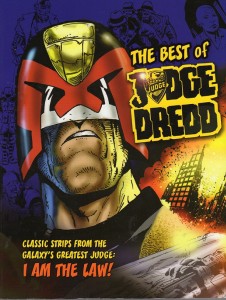Comic Book Review: The Best of Judge Dredd edited by Tharg
It is the dark future of the 22nd Century. Nuclear war and environmental devastation have made large portions of Earth’s surface barely inhabitable, and the majority of the remaining population is crowded into sprawling urban areas called Mega-Cities. Overpopulation, high unemployment, and a general social despair have caused crime to skyrocket. To combat this, most law enforcement has been turned over to an elite force of Judges, who act as police, the judicial system and the prison system all in one. It takes a special breed of human to become a Judge, and the most legendary of these is Judge Dredd.
Judge Dredd first appeared in the second issue of the British comic weekly 2000 AD in 1977, but quickly became the magazine’s flagship character. The strip combined dystopian science fiction with dark humor and Dirty Harry style violence. Over the course of the first few years, the Judges went from an adjunct to the regular police force to the only viable government of Mega-City One due to repeated disasters. As a literal police state, the Judges tackled any problem by criminalizing it, the flaws in this becoming more obvious with time.
Dredd himself is an antihero, an incorruptible man who is trying his best to make the system work, but the system is so oppressive that it crushes the people beneath it, even when properly applied. And one of the recurring themes is that the Judge system lends itself to corruption and abuse, and fails even at its most basic purpose of reducing crime. Judge Dredd may be fair, but he’s harsh.
The first story in this volume is the first Judge Dredd story, and contains only the seeds of these themes. “Meet Judge Dredd” by John Wagner (writer droid) and Carlos Ezquerra (art droid) introduces Dredd as he avenges the death of a fellow Judge. The criminals are holed up in the old Empire State Building, now a dwarf building compared to the mile-high construction around it. The Judges’ advanced crimefighting motorcycles and firearms are introduced, but it is the prison the head criminal Whitey is put in that shows the most imagination. “Devil’s Island” is a traffic island, surrounded by mega-freeways constantly flowing with high-speed traffic. There’s no wall or fence, but just try crossing to safety!
There are several fine single stories, including the first appearance of Rico, Joe Dredd’s corrupt and vengeful clone-brother. While he dies at the end of that chapter, Rico’s legacy affects Dredd for decades. This volume also has bits of several of the epic stories that ran for months in the strip, including the Cursed Earth saga and the Judge Child storyline. If there is one flaw in this volume, it’s that they only have those fragments.
However, all of “America”, which was the first storyline in the Judge Dredd Megazine monthly magazine, is included, in full color. This hits the dystopian elements hard, as the child of immigrants is named after their dream of a better life, but the America they’re thinking of is long dead, and eventually so is the title character when she tries fighting for her ideals. The story is told from the perspective of her childhood friend, with a bizarre science fiction twist at the end. It’s a hard-hitting story, and perhaps the best in this book.
The weakest story for me is “Mrs. Gunderson’s Big Adventure.” A profoundly deaf and legally blind senior citizen is embroiled in the escape of a crime boss who has unfortunately for him attracted the attention of Judge Dredd. The “humor” stems from Mrs. Gunderson being almost completely unaware of what’s going on around her due to her sensory handicaps, and swiftly grows tedious.
Also of note are the first two appearances by serial killer P.J. Maybe who is only thirteen years old at that point. It feels like the second story was created first, and the first story written to make sure the reader realizes that Maybe is not the good guy here. In the first story, he kills two random people and their pet vulture, just to establish that he can. In the second, Maybe wipes out the obnoxious relatives that stand between his family and a fortune in manufacturing. (It took a long time for Judge Dredd to figure out that there was a serial killer, let alone that P.J. Maybe was him. Years later, Maybe was the best mayor Mega-City One ever had, while remaining a remorseless serial killer.)
In addition to the expected ultra-violence, there’s some nudity and sexual situations.
This volume is a good choice for an introduction to Judge Dredd and his setting, with a variety of his writers and artists (including Brian Bolland) represented. Recommended to fans of dystopian science fiction and dark humor.

